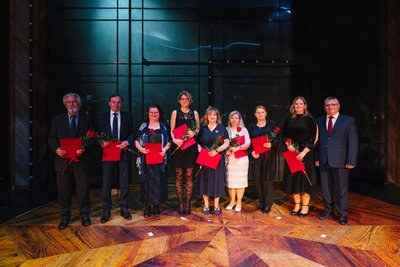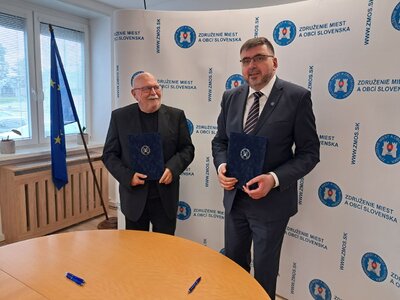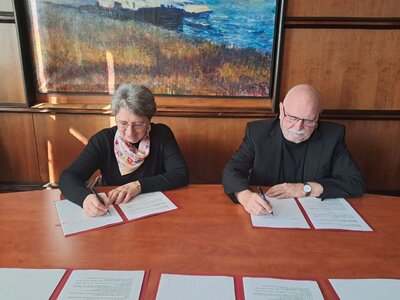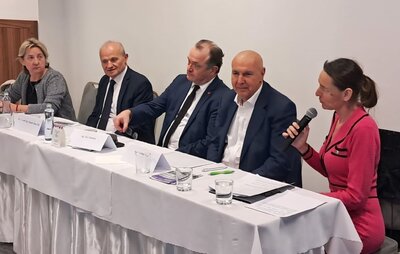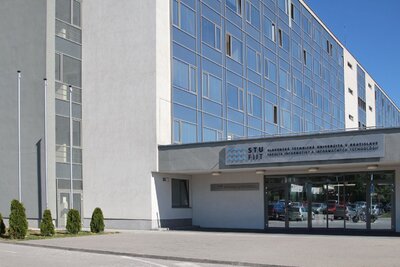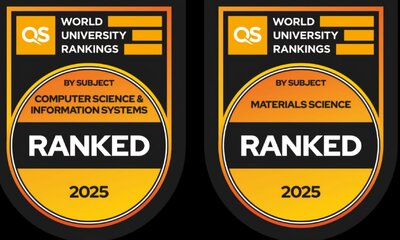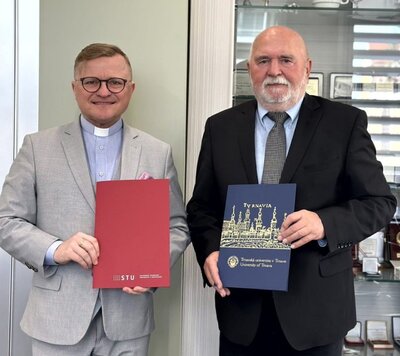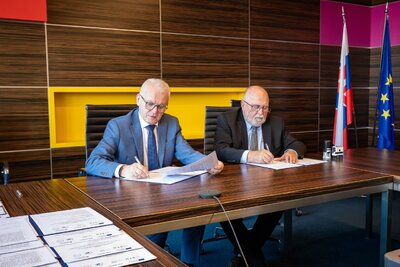Jedno z najväčších vedeckých ocenení pre STU získal v roku 2019 Ján Szolgay, prorektor univerzity a profesor hydrológie na Stavebnej fakulte.
Ján Szolgay získal prestížnu Volkerovu medailu od Medzinárodnej asociácie hydrologických vied, tá ju udeľuje v spolupráci s UNESCO a Svetovou meteorologickou organizáciou a v oblasti hydrológie patrí celosvetovo k najviac prestížnym, inžiniersky orientovaným oceneniam. Je to obrovský osobný úspech profesora Szolgaya a satisfakcia za desiatky rokov špičkovej vedeckej práce, aj veľká prestíž nie len pre slovenskú hydrológiu, ale celú slovenskú vedu a tiež pre Slovenskú technickú univerzitu. Gratulujeme!

Podľa vyjadrenia poroty získal Szolgay toto ocenenie ako uznanie za "medzinárodne rešpektované vedecké príspevky v oblasti aplikovaného hydrologického výskumu, s praktickým dopadom v prospech spoločnosti. Vo svojej vedeckej kariére výnimočným spôsobom prispel k lepšiemu pochopeniu vzniku povodní a jeho zistenia viedli k zlepšeniu protipovodňových opatrení."
Toto vyjadrenie poroty potvrdzuje aj fakt, že Ján Szolgay za ostatné dva roky publikoval v spoluatorstve články v dvoch najvýznamnejších vedeckých časopisoch sveta: Nature a Science.
Podľa Jána Szolgaya je Volkerova medaila ocenením pre celé generácie slovenských hydrológov, ktorí "verili v potrebu integrovať našu hydrológiu do podunajského regiónu a v širších súvislostiach aj do celosvetového diania." Spomína pritom na mnohých svojich predchodcov a kolegov slovami jedného z nich, už nebohého Ľudovíta Molnára: "Zašli sme ďaleko. Poznali a rešpektovali nás v mnohých kútoch sveta. Keď sme so sebou niesli vodu, vítali nás všade. Aj v Paríži alebo Ženeve."

Prinášame Laudatio od profesora Viedenskej univerzity Güntera Blöschla, ktoré zaznelo pri slávnostnej príležitosti odvzdávania Volkerovej medaily a uverejňujeme tiež odpoveď Jána Szolgaya - veľmi pekný a osobný text, v ktorom sa vyznáva k oddanosti vede a ideálom otvoreného, spoločne produkovaného a zdieľaného poznania vo vedeckej komunite.
Laudatio given by Professor Günter Blöschl
Professor Ján Szolgay of the Slovak Technical University, in a hydrological career of more than four decades, has made outstanding contributions to understanding floods and droughts and applying this understanding to furthering water resources planning and design.
(a) Outstanding contributions to hydrology: Ján has significantly advanced engineering hydrology in many areas. He developed novel methods of extreme rainfall estimation with excellent estimation properties, as demonstrated in his 2009 paper in Atmospheric Research, which have received wide international acclaim. He conceived a hybrid approach to delineating homogeneous regions for regional rainfall and flood frequency analysis based on the seasonality of rainfall and floods that accounts for different causal mechanisms such as convective storms and snowmelt. The approach was shown to be more reliable than traditional methods, particularly in the presence of climate change. The multilinear flood routing model he developed in his 2004 paper in the Journal of Hydrology and Hydromechanics has become a classic as it is parsimonious and more robust than alternative methods that provide similar forecasting accuracy. The model is widely used in operational forecasting models, e.g., for the Danube river. In his 2005 paper in Hydrology and Earth System Sciences he proposed a clever alternative to seasonal flood forecasting models that uses real-time soil moisture data along with extreme rainfall statistics and experience on the basin response from historical floods. This approach closes the link between short-term forecasts and flood risk estimates in the spirit of seamless flood predictions. His research on climate and land use impacts on runoff accounts for the specifics of runoff generation at various scales, including in ungauged basins. Ján’s methods extract a maximum of information from a minimum of data by indexing the most important processes, striking a fine balance between robustness and process basis. With an increasing need for hydrological information in data-scarce regions, his contributions to engineering hydrology cannot be overestimated.
(b) International dimension of his research: Ján’s research is closely linked to the Danube basin, the most international river basin of the world. His regional analyses of extreme rainfall, floods and droughts specifically focus on hydrological differences between regions within the Danube basin. For example, he developed a typology of flood peak and flood volume relationships to provide guidance on model selection in extreme value analysis for different regions. This research was supported by numerous international activities, such as his tutorship in UNESCO postgraduate courses in Prague and Budapest, and in countless international symposia, and his supervision of hundreds of master students and two dozens of doctoral students from around the world. As a Regional Expert and Lead Author of the Third Assessment Report of Intergovernmental Panel on Climate Change (IPCC TAR) he co-authored the chapter on Europe of the 3rd IPCC Assessment Report and is an expert reviewer of the last assessment report. His most recent initiative, the Hydrocarpath conference series aimed at networking young hydrologists from the region, has been enthusiastically received by PhD students. These and other activities have very successfully connected Eastern European hydrology with the wider world.
(c) Research for the benefit of society: Ján’s research had a major impact on water resources practice through developing methods that are both accurate and robust. For example, he developed a stochastic streamflow generation model that has excellent properties at annual, monthly and daily aggregation levels in terms of representing floods and droughts. It was used in numerous practical studies, such as in identifying ecologically viable operating rules for the Danube inland delta, and for optimising the trade-off between reactivating former floodplains and constructing flood detention reservoirs for flood proving the Morava River. As an advisor to the Czech River Authorities, he developed a process based flood peak-volume model which was used for re-evaluating the cascade of reservoirs above Prague after the catastrophic 2002 flood. Ján also had an immense influence on practice in his role as an expert of highest international standing. He has served on numerous committees that guide and shape water management in various countries of the Danube basin. He chaired the ministerial Committee on Integrated Watershed Management in Slovakia, serves as a regional expert to the Government of Hungary on the National Water Research Program. Ján has been instrumental in developing technical standardisation on floods and droughts that go beyond ISO and CEN standards, in both Slovakia and other countries, by establishing codes of practice for scientifically sound data collection and design flood estimation methods.
(d) Contributions to IAHS or other international hydrological associations: Ján Szolgay has very actively contributed to IAHS for decades. The 'Hydrology 2000' report of IAHS on hydrology and water management he co-authored in 1987 has foreshadowed, and indeed influenced, many of the later developments, including how to deal with environmental change. He co-founded the Slovak Committee on Hydrology that represents the country both to IAHS and UNESCO-IHP. He has been an IAHS National Representative for years and has stimulated IAHS research activities through his role as a convenor and author at dozens of IAHS conferences. He has also very actively contributed to EGU as the founding chair of the Hydrological Forecasting Subdivision, chair of the Catchment Hydrology Subdiviion and in other roles. He has been a leading force in organising and shaping the content of the biannual conferences of the Danubian countries on hydrological forecasts and water management, which have had a major impact on hydrology and water resources practice in the region. Ján has also served the community in editorial roles, e.g. as an editorial board member of Hydrological Sciences Journal, the Journal of Hydrology, and other journals.
(e) In summary, Ján Szolgay is an amazing personality with an uncanny ability to identify the heart of a water resource problem and find solutions that are both theoretically sound and practical. He has made very significant contributions to flood and drought hydrology in international river basins which has earned him an immense reputation among practitioners and academics alike. He has served society by developing and implementing novel estimation and forecasting methods and has served the hydrologic community, including IAHS, in leading roles. Professor Ján Szolgay is therefore a very worthy recipient of the 2019 Volker Medal.
Günter Blöschl, IAHS President

Response by Professor Ján Szolgay
I am honored, glad, and grateful to receive this award from IAHS, UNESCO and WMO and such a positive evaluation by the proposers, whom I also owe many thanks. However, the real merit for deserving this medal has to be attributed to many colleagues and friends who accompanied me or crossed my ways and also to the organizations awarding it, to the IAHS, with UNESCO and WMO. I also had a significant portion of luck at several stages of my hydrological career. Without it, I could not be in the position to thank for the medal today. So I would like to acknowledge here the share of the many, who contributed to and therefore share with me this award (and to the good luck accompanying me, whoever was responsible for it).

I started to be a hydrologist in a (non-) splendid isolation in the former "socialist camp" at the Institute of Hydrology and Hydraulics of the Slovak Academy of Sciences right after university and the obligatory year in military service. I was enrolled as a Ph.D. student, with a portion of good luck, given the political constraints imposed on our family after the Prague Spring. From the beginning of my studies, I met a specific challenge for scientists in those times there: not to lose track and contacts with the developments of science at the other side of the Curtain. Though the need to look through the wall was not a motivation to everybody, for me, having, as a teenager experienced an open-world throughout the short year 1968, it became after that almost an obsession. First, naturally, it was about cultural and socio-economic aspects of life, later it concentrated on the development of science and hydrology on the other side. At that time, I had the luck to receive (I really do not know how and why) a British Council grant. I spent some weeks at the former Institute of Hydrology Wallingford mostly with Bob Moore and with Duncan Reed. That experience set high thresholds for my expectations for both the content and logistics of research work. Moreover, Bob and Duncan were engaged in hydrology on the border of the scientific and practical, and I fell in love with that. I was lucky to meet them, and I am greatly indebted to them both. Their support strongly influenced my hydrological thinking and professional ambitions, and part of this medal is theirs's. My continuous striving not to miss the tracks of development got larger than before. From there on, I always wanted to find such values of progress in science, which could survive time. I wanted to look especially for those, which may be transformed into an (our regional) engineering hydrological knowledge.
On the other hand, despite the isolation, there was a quality of scientific life in the camp, too. It is always the case in diasporas, but people outside these tend to ignore it. There were also active and stimulating intercamp (international) cooperations and an exchange (mobility) program. So I could (again luckily) meet strong personalities of the era. To mention really just a few names: Siegfried Dyck, Zdzisław Kaczmarek, György Kovács, Lev Samuilovich Kutchment, Givi Gedeonovich Svanidze, Witold Strupczewski. I could consider myself as a student in a kind of continuous distance learning course. I was also directly educated at the hydrology courses in Moscow, Prague, and Budapest.
Being part of curiosity-driven research at the Academy in combination with the unique traditions of the Czechoslovak water resources management culture enabled me (luckily) to grow up in a cultural mix of basic, experimental and applied research, and western and eastern hydrology. Hydrology in Czechoslovakia was lived in dedicated research, planning, and design institutes, university departments and governmental bodies. At a time there was even a ministry dedicated to water and forest management in Czechoslovakia. There was science-based institutionalized catchment-based systematic predictive planning from the early fifties of the last century on. Personalities like Oto Dub, Milan Dzubák, Karel Nacházel, Adolf Patera (to name just those who were really mostly close to me professionally or personally), were leading us to application-driven research. Results were implemented into dozens of design codes used by all branches of water resources management. The responsibility for safe guidelines, reliable models, and formulae based on sparse data and the study of regional patterns was large, and I still bear it in me. Vít Klemeš, who was also for some time with our Institute, before leaving the country, was also part of this development, and often gave (anecdotical) references to these times in his papers. His hydrology of common sense was present in our group at the Institute. I was again lucky to be able to absorb, led by his close friends Aleš Svoboda and Ľudo Molnár, a good deal of it. All share therefore a part of this medal, too.
Hydrologists, starting with the advent of the systematic planning in the fifties, appeared in generational waves in Czechoslovakia. So we were many youngsters at the Institute. Scarcity of many essential constituents needed in the research was luckily compensated for by solidarity. There was an almost family atmosphere, which outweighed problems. So Palo Miklánek, Pavla Pekárova, Ivan Mészáros, Jano Slodička (and later Rado Tihlárik) can also claim an award share. Without the support and self-sacrifice of our technical staff, we would not have made it. Shares also go to Valent Bezák, Božka Cagalincová, Jarka Feketová, and Štefan Šedivý.
Despite the shortcomings, there was also considerable freedom in science (in choosing topics one wanted to conduct), in fact much more substantial, than one would believe now. Being in a high position (especially in institutions of fundamental research) guaranteed this. That was, of course, motivating to many to advance in a career. However, many times, such an advance in position also meant engagement with the political establishment. The Institute was politically expected to engage itself in the real-life of water resources management in the country. My decision was not to take an ethical compromise, so I (and some colleagues) became engaged in the less appreciated area of applied hydrology and hydraulics. That was not really a constraint to me, but a good portion of different freedom. That required to look for solutions for the practical, to take responsibility for the useful and functional. That type of freedom nobody wanted to take away from us. We became engaged in smaller and larger local, national (and partly international) projects of those times. Among these were the amelioration project of the Eastern Slovakian Plane, Flood Forecasting System in East Slovakia, the Gabčíkovo-Nagymaros hydropower scheme, renaturation of the Morava floodplains, etc.
These tempted us to combine progress in science with the conservatism of engineering, constraints, and uncertainties in data. Working on continuous revisions of design codes was another output motivating our research. So I was again lucky. Lucky to have the chance of a comfortable political compromise with the regime, if you want. So (ironically), this medal may, in a way be therefore dedicated to that political establishment, too. Methods we developed were much later further polished and published, and some are cited in the proposal for the award.
IAHS, UNESCO, and the WMO played a more significant role in keeping us connected to the world much more than one would expect. These organizations were recognized by the authorities (in fact they had to be whether wanted or not). They enabled contacts, travel (both ways) and participation in international conferences, programs, and projects. The IAHS Hydrology 2000 working group was a representative example of treating our part of the world equally. It further motivated me to perform comparably with the world, and I owe many thanks to David Collins and Lars Gottschalk. The (unfortunately long-gone) UNESCO sponsored courses (in my case especially those in Budapest and Prague) also have to be mentioned as focal points for meetings with colleagues, professional development and awareness raising for the needs of the so-called developing world. All this was of great value to many of us, and I am thankful to these bodies for that. So quite a share of the medal goes also to them.
The Danube basin was a natural playground for international hydrological life. Many colleagues from the upper Danube were wholeheartedly engaged in helping us and motivating us. Among these, I am personally very profoundly indebted to Dieter Gutknecht and Heinz Bergmann and later to Günter Blöschl. They have treated us as equal partners, understood deficiencies caused by circumstances and valued qualities we had (and hopefully still have). I am also indebted to many colleagues in the Danube basin downstream of Bratislava. We spent many useful hours of discussions in the framework of the IHP UNESCO projects. I have to mention at least Gábor Bálint, Mitja Brilly, Ogjen Bonacci, Dobri Dimitrov, István Kontur, Stefan Prohaska, János Szabó, who (but also others) therefore deserve to get a part of the medal, too.
Some of the younger generations have found their way out into the outer world. I could luckily consider many of them not only as collaborators, but later as supporters on my way into international hydrology, and also as good friends. Part of the medal also goes to Zbyszek Kundzewicz, Andreas Schumann, András Szöllősi-Nagy, (and others).
The possibility to leave the Academy and enter the field of education of engineering students at the Slovak University of Technology came by a lucky circumstance. University life further motivated me to follow (maybe too) many parallel topics and strive to gain sufficient experience with methods enabling critical examination of their application potential and usefulness for improving water resources design and management methods in a broad sense. The essential motivation behind that is my belief that it is necessary to be credible when making statements to students on techniques. Such credibility can only be achieved by either personal or closely mediated experience. It also allows to innovate syllabi and by that to send knowledge to the practicing engineering community by messengers. It also explains, why in the citation there are many topically disjunct methods. In our team (Michaela Danáčová, Laco Gaál, Kamila Hlavčová, Silvia Kohnová, Vlado Mosný, Peter Valent and Roman Vyleta) we were mentoring dozens of bachelor, master and Ph.D. research studies. These covered a vast diversity of topics. We could do so only because we were lucky to have, by tradition, specialized bachelor and master courses for water resources engineering. We systematically tried to (critically) examine newly available methods for the potential of applicability in the given socio-hydrologic and physiographic context of Slovakia or Central Europe. We were also fortunate to find colleagues at the ministries, the Slovak River Authority and the Slovak Hydrometeorological Institute, who were letting us test and develop new methodologies for planning and help to maintain a set of local design codes. Only a part of this knowledge made it into international papers. With colleagues from the (now) Institute of Hydrology, we documented this testing in articles in Slovak in Acta Hydrologica Slovaca. By that, we kept track of these and conveyed results to students and practitioners. The list of medal contributors would so become too long to be listed here. Among those Ph.D. students, who made it also to be achieving internationally, I am grateful to Juraj Čunderlík, Milan Kalaš, Peter Molnár, and Juraj (Duro) Parajka.
I dare to say, that the clearly distinguishable hydrological problem-solving culture emerged in the Danube basin and to the East of it. Parts of that remain partly undiscovered to these days and sadly will fade out on its Darwinian limb of development through history. Opening the world brought a new challenge: how to integrate ourselves and still keep our way of hydrologic thinking. The integrating platforms of the IAHS, UNESCO, and WMO was joined by the EGU. Günter Blöschl, Alberto Montanari, Hubert Savenije and many others therefore also participate in the medal.
We would not have made it without good luck personified in the courage and personal engagement of many colleagues. They dared, not wholly knowing us, to take us on board of projects, and charged us with responsibilities, engaged us into the organization of European and global scientific life. I am thankful and indebted to many, who considered it to be their personal and professional duty. So many colleagues being brought up in this culture entered international playgrounds. We were bringing remains of the problem-solving culture with us and planted it as seeds. Ideas born in the past were further developed, and in many cases found their way into the papers also mentioned in the citation. Cooperation with Marco Borga, Paolo Burlando, Eric Gaume, Thomas Kjeldsen, Peter Molnár, Boris Sevruk, Ezio Todini, and especially Günter Blöschl and his team (Duro Parajka, Ralf Merz, Alberto Viglione), which I am incredibly grateful for, deserve a share in the award.
Meeting so many excellent hydrologists was also a good share of luck. However, the most valuable portion of luck is my family and their support, which made everything possible. In the end, I can hopefully conclude to have managed to show that one is never alone responsible for one's performance. Besides a good portion of luck (or however else we may call it), one needs friends. Hydrology is a good ground for friendships. So the medal is in fact not mine, but it belongs to all who co-formed me, my views on hydrology and its socio-hydrologic roles. By extrapolation, it goes to all, who are living the way of being an engineering hydrologist. So, in the end, it belongs to all those, for whom this medal was established. And it is good so.
Ján Szolgay
--
Zdroj:https://iahs.info/About-IAHS/Competition--Events/International-Hydrology-Prize/International-Hydrology-Prize-Winners/J-Szolgay.do

